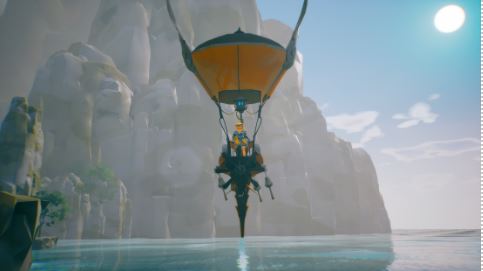
TASOMACHI: Behind The Twilight is a 3D platformer developed by Orbital Express and published by PLAYISM. Orbital Express is led by veteran industry artist, nocras, who has worked on hits such as Final Fantasy XIV: A Realm Reborn, The Legend of Zelda: Breath of the Wild, and Pokémon Sword and Shield. The music is composed by popular Japanese artist, Ujico*, who has over 200 million views on YouTube.
TASOMACHI: Behind The Twilight follows the story of Yukumo, a young girl whose airship becomes damaged at the beginning of the game. She arrives at a seemingly abandoned town covered in deep, dark fog and must search the town for both parts to repair her airship and to help free the town from the darkness. TASOMACHI: Behind The Twilight is a beautifully crafted game that combines smooth and simple gameplay with a stellar soundtrack and delightful settings.
Beauty: Hitting above its Weight

When booting the game up for the first time, the player is presented with only a few options: load/start a game, format a save, settings and quit the game. Let’s start with the settings. Settings are pretty barebones, although it contains everything one would expect from a game’s settings. Graphics range from “lowest” to “highest”, rather than using resolution. I suspect that the way the game calculates “lowest” and “highest” is based on a render scale. SFX and Music volume sliders are important, especially since the majority, if not all that you will be hearing in TASOMACHI: Behind The Twilight will be the music and sound effects. There is nary a dialogue in sight. There are some control and camera settings. I played with my mouse and keyboard but TASOMACHI: Behind The Twilight also has controller support. The controls themselves are pretty simple and intuitive although the camera control on a mouse is a bit too fast. The last major set of settings are the languages, with only a limited number of languages available.

The game is astoundingly beautiful. It looks like it was pulled from a Studio Ghibli movie. The colors are bright and vibrant, the shadows are moody and intense. If you’ve played Breath of the Wild, you’ll definitely feel an urge to go back and play after seeing this game. This game’s aesthetic just screams character and I love it. You don’t need realistic photogrammetry to create a beautiful game and TASOMACHI: Behind The Twilight is a great example of that. However, beautiful graphics does come with its costs so heed this warning! Make sure your graphics card can handle this game! It is incredibly GPU intensive and playing this game on anything lower than high settings takes away one of the most unique aspects of TASOMACHI: Behind The Twilight.
The music is also great and unique, and it fits this style of game with a mix of more orchestral, smooth swaying tracks and more modern synth style music as well. Like the general art style of TASOMACHI: Behind The Twilight, there are aspects of traditional and modern in the soundtrack and I hope Ujico* releases some of the tracks in this game on YouTube. I am in need of some new study music.
The game for the most part, runs smoothly; I rarely experienced any texture pop ins and loading screens are short. Moving your camera around quickly and certain actions can result in relatively harsh frame drops but I found my game still ran relatively well even on the highest resolution. If you’re not a fan of motion blur though, I’d be careful and adjust your camera sensitivity settings as needed. I did find myself feeling a little sick after swinging the camera around quickly to test out the frame drops.
3D Platforming, Stress Free
The gameplay is similar to most other 3rd person platformers (think Crash Bandicoot or even something like Knack). The bulk of the gameplay will rely on your movement, utilizing the standard jumps or the various movement abilities you unlock to beat each Sanctuary. The goal of the game is to collect enough parts and Sources of Earth to repair your ship as well as uncover the mystery of the town you are exploring. Money can be picked up throughout the locations you visit and can be used to skip sections of the Sanctuaries. But what are Sanctuaries?

Sanctuaries act as small parkour dungeons where Yukumo must reach the end of a jumping puzzle to claim a Source of Earth as well as unlock the Sanctuary. The more Sanctuaries a player clears, the more the light will return to the town. These dungeons have a variety of challenging jump mechanics that, although simple to understand and solve, will require a bit of finessing, especially for someone like me who isn’t as proficient at platformers.
Something else that initially worried me was that there was no auto-saving! Saving is done by praying t a shrine, marked by a yellow-green swirl effect. Thankfully, there are plenty of shrines scattered through the sanctuaries and the town. There is a light checkpoint mechanic in place after you complete certain objectives so even if you fail a jump after clearing a section of a Sanctuary, not all of your progress will be lost. The lack of an auto-save is not the punishing handicap that other games exploit to increase difficulty. Instead, it acts as a way for you to regain your spot, so that when you fail the moving platforms section for the 5th time (as I did), you can just return to the start, rather than at the shrine one door away.
My critique of TASOMACHI: Behind The Twilight’s gameplay isn’t really an analysis of the mechanics itself but more a reflection of what kind of gamer would be interested in this kind of game. The levels are relatively simple and most of the game is dependent on exploration through platforming. There is no combat, no life bars, no stamina bars, no rarities, nothing of the sort. The game is designed to not be a stressful boss murdering enemy slaying high octane game but instead a low-stress, almost Zen-like experience. It reminds me of Journey or Ori to a certain extent. A beautiful game with easy to grasp mechanics that exists to wrap the player in its beautiful world like a big warm hug.
A Gamer’s Nirvana

TASOMACHI: Behind The Twilight is almost inviting you to simply take in the sights and sounds of its world at your pace. Imagine most popular video games as a 100-meter sprint at the Olympics. TASOMACHI: Behind The Twilight is that nice stroll through the park as the spring breeze gently blows past you, the sounds of birds chirping in the air and flowers starting to bloom.
If this is something you are not interested in, this is just not the game for you. However, for fans of platformers, for fans of the art style of nocras, for fans of the music (trust me, after a few sessions with TASOMACHI: Behind The Twilight, you will be) or for people who just want to take a break and play a nice, relaxing game: TASOMACHI: Behind The Twilight is worth picking up.

It honestly might be worth picking up just for the visuals alone, walking through a section that you’ve restored to the light and basking in its beauty may be worth the price of admission. No YouTube video or Twitch stream of this game will do it justice, and this was just on my 1080p monitor. I can only imagine how crisp and glorious the art style would be in 4K.
TASOMACHI: Behind The Twilight is not a demanding game. It doesn’t ask a lot of the players. There aren’t any boss fight patterns to memorize, team plays to execute, loot boxes to grind or any of the flashy features of most modern games. Instead, this game is a meditation, the gamer’s Zen garden. If a peaceful game is what you’re looking for, TASOMACHI: Behind The Twilight is the game for you.
10/10
Check Out the TASOMACHI: Behind The Twilight Trailer:
TASOMACHI: Behind The Twilight releases tomorrow, Wednesday, April 14, 2021, via Steam and GOG for Windows PC, with Japanese, English, and Chinese (Simplified and Traditional) language text.
For more information, please visit the PLAYISM website, follow PLAYISM on Facebook and Twitter, and search for #Tasomachi on social media.
Steam Review
My name is Matt Tran and I have been playing video games since I could remember holding a controller. I've always been a hardcore gamer growing up, from the hectic MW2 and Halo 3 lobbies, my many journeys through several Halo clans and my current exploits with my Destiny 2 clan. I love shooters and RPGs and overanalyzing every component of every game I've played, from weapon stats to ideal perks. When I have time to play other games, I currently play Genshin Impact and Star Wars Squadrons.






More Stories
Highly Anticipated Post-Apocalyptic MMO FPS, PIONER, Launches on Steam Early Access
DAIMON BLADES Preview for Steam Early Access
ReStory Preview for Steam